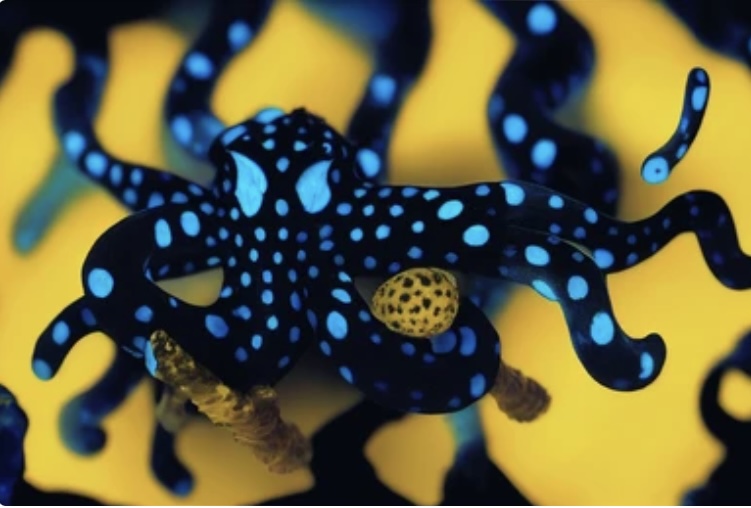INTRODUCTION

Coloration plays a crucial role in the lives of many animals, serving diverse purposes such as camouflage, communication, courtship, and warning signals. One remarkable mechanism that enables animals to achieve stunning color changes is the presence of specialized pigment-containing cells called chromatophores. Chromatophores possess the extraordinary ability to alter their coloration, allowing animals to adapt to their surroundings, convey important visual signals, and respond to environmental cues. In this article, we delve into the captivating world of chromatophores, exploring their structure, types, functions, and the intricate regulatory mechanisms that govern their activity across different animal groups.
STRUCTURE AND TYPES OF CHROMATOPHORES
Chromatophores are cellular structures found in a wide range of animals, including fish, reptiles, amphibians, cephalopods, and certain invertebrates. Although they exhibit variations in structure and composition, chromatophores generally consist of pigment-filled sacs or vesicles surrounded by specialized cells.

- Melanophores: Melanophores contain the pigment melanin, which can be brown, black, or gray. These cells are responsible for producing dark coloration and are primarily involved in camouflage, UV protection, and thermoregulation. Melanin granules within melanophores can disperse or aggregate, leading to changes in color intensity and pattern.
- Xanthophores and Erythrophores: Xanthophores and erythrophores contain yellow or red pigments, such as carotenoids. These cells contribute to vibrant yellow and red coloration in animals. Xanthophores are responsible for producing yellow or orange hues, while erythrophores produce red coloration, often through the presence of specialized pigments like pteridines.
- Iridophores: Iridophores contain reflective platelets or crystals that produce structural coloration, often appearing iridescent or metallic. These cells reflect and scatter light, resulting in a diverse range of colors. Iridophores are particularly common in fish and reptiles, contributing to their striking visual displays.
REGULATION OF CHROMATOPHORE FUNCTION
The ability of chromatophores to change color and pattern is regulated by an intricate interplay of physiological, neural, hormonal, and environmental factors. The regulation of chromatophore function is crucial for animals to adapt to different environments, communicate with conspecifics, and engage in various behavioral and ecological interactions.
- Neural Control: In many animals, chromatophore activity is controlled by the autonomic nervous system, specifically through the sympathetic and parasympathetic pathways. Neural signals originating from sensory organs or central control centers reach the chromatophores, triggering specific responses. For example, visual stimuli or environmental cues can activate specific neurons that stimulate or inhibit chromatophore activity.
- Hormonal Control: Hormones play a significant role in the regulation of chromatophore function. Hormonal signals can originate from various sources, including the brain, pituitary gland, and peripheral organs. In amphibians and reptiles, melanocyte-stimulating hormone (MSH) and corticotropin-releasing hormone (CRH) influence melanophore activity and color changes. In cephalopods, such as squids and octopuses, neurotransmitters like serotonin and acetylcholine regulate chromatophore function.
- Environmental Factors: The activity of chromatophores can be influenced by various environmental factors, including light intensity, temperature, humidity, and background coloration. Animals have evolved mechanisms to detect and respond to these environmental cues, allowing them to adjust their coloration to enhance camouflage, thermoregulation, or communication. For example, certain fish species can detect changes in light intensity and adjust their chromatophore activity accordingly.
- Behavioral Significance: Chromatophore activity is closely intertwined with animal behavior. Color changes in chromatophores can be elicited by external stimuli, social interactions, courtship displays, or responses to threats. Animals can rapidly modulate their chromatophore activity to convey messages to conspecifics, establish dominance hierarchies, attract mates, or intimidate rivals or predators.
EXAMPLES OF CHROMATOPHORE FUNCTION AMONG ANIMALS

- Chameleons: Chameleons are renowned for their remarkable color-changing abilities. Through their chromatophores, they can adjust their coloration to match their surroundings or communicate their mood and intentions. Chameleons utilize a combination of neural control and hormonal regulation to achieve their impressive color transformations.
- Cuttlefish: Cuttlefish possess highly developed chromatophores that allow them to change color and pattern instantaneously. They use their chromatophores to mimic the colors and textures of their environment, effectively camouflaging themselves from predators or prey. Cuttlefish can also employ rapid and intricate color displays to communicate with conspecifics during courtship rituals or territorial disputes.
- Cephalopods: Octopuses and squids are masters of using chromatophores for camouflage and communication. These intelligent creatures can rapidly change their skin coloration and patterns, adapting to different backgrounds and effectively disappearing from sight. They can also use their chromatophores to create complex visual displays, sending specific messages to other individuals.
- Fish: Several fish species, such as the peacock mantis shrimp or the mandarinfish, possess chromatophores that enable them to change their coloration. These color changes are often associated with courtship displays, territorial defense, or communication within a school. Fish can adjust their chromatophores to match their surroundings or signal their reproductive status.
CONCLUSION
Chromatophores and their regulation of function among animals are remarkable biological adaptations that enable creatures to display stunning color changes, adapt to their environment, communicate with conspecifics, and participate in important behavioral interactions. The interplay between neural, hormonal, and environmental factors governs the activity of chromatophores, allowing animals to achieve diverse and intricate coloration patterns.
Understanding the mechanisms underlying chromatophore function enhances our knowledge of animal behavior, sensory ecology, evolutionary biology, and the complex interrelationships between animals and their environments. Further research on chromatophores across different animal groups will undoubtedly reveal additional insights into the evolutionary significance of coloration, communication strategies, and the fascinating adaptations that enable animals to thrive in diverse ecological niches
Discover more from ZOOLOGYTALKS
Subscribe to get the latest posts sent to your email.


https://pq.hosting/vps-vds-czechia-prague